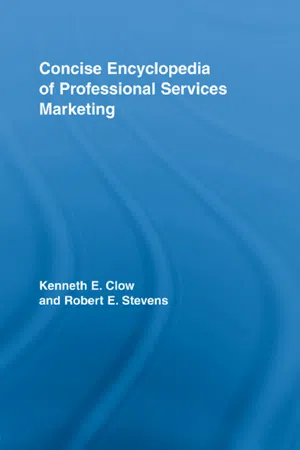
Concise Encyclopedia of Professional Services Marketing
- 166 pages
- English
- ePUB (mobile friendly)
- Available on iOS & Android
Concise Encyclopedia of Professional Services Marketing
About This Book
Concise Encyclopedia of Professional Services Marketing provides readers with a detailed account of the concepts and strategies necessary to successfully market professional services and grow a business. Complete with practical information relevant to a wide range of professionals--including accountants, architects, attorneys, consultants, dentists, engineers, and physicians--this guidebook is an indispensable reference for anyone looking to learn the concepts and applications needed to market professional services.
In addition to essay-length articles arranged from A to Z, and detailed expositions of both the theories and practical techniques necessary to formulating and executing a successful marketing plan, Concise Encyclopedia of Professional Services Marketing contains an appendix of information on launching a multimedia advertising campaign, with special focus on effective website design and other contemporary media formats. For anyone creating their own business or looking to expand an already existing one, Concise Encyclopedia of Professional Services Marketing is a comprehensive and vital reference.
Frequently asked questions
SWOT Analysis
| Type | Description | Purpose |
| Surveys | Service satisfaction surveys of customers following a service encounter. | Obtain feedback while service is still fresh; act on feedback quickly if negative patterns develop. |
| Mystery Shopping | Researchers become “customers” to experience and evaluate the quality of service delivered. | Measure individual employee service behavior for use in coaching, training, performance evaluation, recognition, and rewards; identify systematic strengths and weaknesses in customer-contact service. |
| New, declining, and lost-customer surveys | Surveys to determine why customers select the firm, reduce their buying, or leave the firm. | Determine the role service quality and other issues play in customer patronage and loyalty. |
| Focus group interviews | Small group interactions of usually eight to twelve people. Questions focus on a specific topic. Can be used with custo... |
Table of contents
- Cover Page
- Title Page
- Copyright Page
- Preface
- Acknowledgments
- Access
- Active Listening
- Adoption Process
- Advertising Message
- Atmosphere
- Attitude Measurement
- Benefits of Marketing
- Brand Equity
- Branding Decisions
- Budgets
- Business Development (Rainmaking)
- Client/Patient Analysis
- Clients/Patients Behavior
- Clients/Patients Satisfaction
- Clients/Patients Service
- Communication Methods
- Communication Process
- Competition
- Competitive Advantage
- Controlling Marketing Activities
- Costs to Target Audience
- Data Collection
- Data Collection and Analysis
- Database Marketing
- Demographics
- Descriptive (Quantitative) Research
- Direct Marketing
- Environmental Scanning
- Exchange
- Exploratory (Qualitative) Research
- Facility Design
- Family Life Cycle
- Fee Level Decisions
- Geodemographics
- Grid Analysis
- Implementation
- Improving Customer Perceptions of Service Quality
- Internal Marketing
- Location Analysis
- Market Exposure Decisions
- Market Potential
- Market Segmentation
- Marketing
- Marketing Communications
- Marketing Mix
- Marketing Orientation
- Marketing Plan
- Marketing Planning
- Marketing Research
- Mass Communication Media
- Measurement
- Media Decisions
- Message Content
- Moments of Truth
- New Service Development
- New Service Pricing Decisions
- Niche Marketing
- Objective Areas
- Objectives
- Organization and Program Life Cycles
- Organization Structure
- Performance Evaluation and Control
- Planning Audits
- Positioning
- Primary Data
- Product Market Analysis
- Product Positioning Strategies
- Promotion Budget
- Promotional Mix
- Publicity
- Quality- and Value-Based Marketing
- Questionnaire
- Research Design
- Research Methodology
- Revenue/Cost Controls
- Sampling
- Scales
- Secondary Data
- Service Offerings
- Services Portfolio
- Service Strategy
- Survey Research
- SWOT Analysis
- Target Audience
- Appendix: Tips for Creating Effective Advertisements